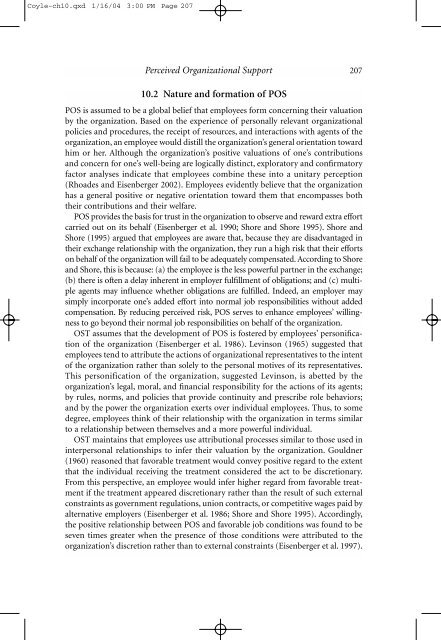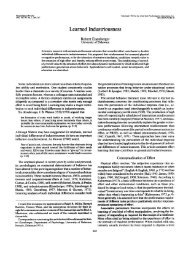Perceived Organizational Support
Perceived Organizational Support
Perceived Organizational Support
Create successful ePaper yourself
Turn your PDF publications into a flip-book with our unique Google optimized e-Paper software.
Coyle-ch10.qxd 1/16/04 3:00 PM Page 207<br />
<strong>Perceived</strong> <strong>Organizational</strong> <strong>Support</strong> 207<br />
10.2 Nature and formation of POS<br />
POS is assumed to be a global belief that employees form concerning their valuation<br />
by the organization. Based on the experience of personally relevant organizational<br />
policies and procedures, the receipt of resources, and interactions with agents of the<br />
organization, an employee would distill the organization’s general orientation toward<br />
him or her. Although the organization’s positive valuations of one’s contributions<br />
and concern for one’s well-being are logically distinct, exploratory and confirmatory<br />
factor analyses indicate that employees combine these into a unitary perception<br />
(Rhoades and Eisenberger 2002). Employees evidently believe that the organization<br />
has a general positive or negative orientation toward them that encompasses both<br />
their contributions and their welfare.<br />
POS provides the basis for trust in the organization to observe and reward extra effort<br />
carried out on its behalf (Eisenberger et al. 1990; Shore and Shore 1995). Shore and<br />
Shore (1995) argued that employees are aware that, because they are disadvantaged in<br />
their exchange relationship with the organization, they run a high risk that their efforts<br />
on behalf of the organization will fail to be adequately compensated. According to Shore<br />
and Shore, this is because: (a) the employee is the less powerful partner in the exchange;<br />
(b) there is often a delay inherent in employer fulfillment of obligations; and (c) multiple<br />
agents may influence whether obligations are fulfilled. Indeed, an employer may<br />
simply incorporate one’s added effort into normal job responsibilities without added<br />
compensation. By reducing perceived risk, POS serves to enhance employees’ willingness<br />
to go beyond their normal job responsibilities on behalf of the organization.<br />
OST assumes that the development of POS is fostered by employees’ personification<br />
of the organization (Eisenberger et al. 1986). Levinson (1965) suggested that<br />
employees tend to attribute the actions of organizational representatives to the intent<br />
of the organization rather than solely to the personal motives of its representatives.<br />
This personification of the organization, suggested Levinson, is abetted by the<br />
organization’s legal, moral, and financial responsibility for the actions of its agents;<br />
by rules, norms, and policies that provide continuity and prescribe role behaviors;<br />
and by the power the organization exerts over individual employees. Thus, to some<br />
degree, employees think of their relationship with the organization in terms similar<br />
to a relationship between themselves and a more powerful individual.<br />
OST maintains that employees use attributional processes similar to those used in<br />
interpersonal relationships to infer their valuation by the organization. Gouldner<br />
(1960) reasoned that favorable treatment would convey positive regard to the extent<br />
that the individual receiving the treatment considered the act to be discretionary.<br />
From this perspective, an employee would infer higher regard from favorable treatment<br />
if the treatment appeared discretionary rather than the result of such external<br />
constraints as government regulations, union contracts, or competitive wages paid by<br />
alternative employers (Eisenberger et al. 1986; Shore and Shore 1995). Accordingly,<br />
the positive relationship between POS and favorable job conditions was found to be<br />
seven times greater when the presence of those conditions were attributed to the<br />
organization’s discretion rather than to external constraints (Eisenberger et al. 1997).



